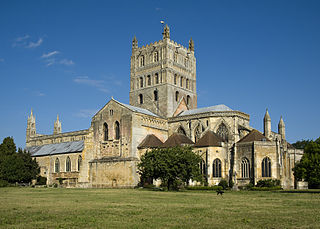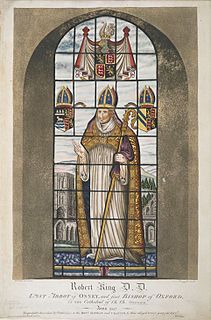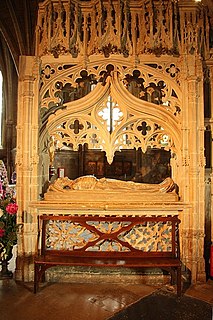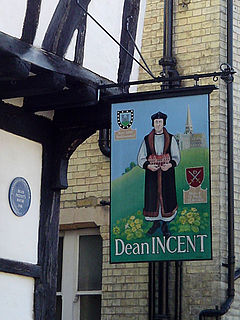Related Research Articles

The Abbey Church of St Mary the Virgin, Tewkesbury–commonly known as Tewkesbury Abbey–is located in the English county of Gloucestershire. A former Benedictine monastery, it is now a parish church. Considered one of the finest examples of Norman architecture in Britain, it has the largest Romanesque crossing tower in Europe.

Peterborough Cathedral, properly the Cathedral Church of St Peter, St Paul and St Andrew – also known as Saint Peter's Cathedral in the United Kingdom – is the seat of the Anglican Bishop of Peterborough, dedicated to Saint Peter, Saint Paul and Saint Andrew, whose statues look down from the three high gables of the famous West Front. Although it was founded in the Anglo-Saxon period, its architecture is mainly Norman, following a rebuilding in the 12th century. With Durham and Ely cathedrals, it is one of the most important 12th-century buildings in England to have remained largely intact, despite extensions and restoration.
John Bell was a Bishop of Worcester (1539–1543), who served during the reign of Henry VIII of England.

Ely Cathedral, formally the Cathedral Church of the Holy and Undivided Trinity, is an Anglican cathedral in the city of Ely, Cambridgeshire, England.

The Diocese of Peterborough forms part of the Province of Canterbury in England. Its seat is the Cathedral Church of Saint Peter, Saint Paul and Saint Andrew, which was founded as a monastery in AD 655 and re-built in its present form between 1118 and 1238.
Nicholas Shaxton was an English Reformer and Bishop of Salisbury.

The Diocese of Westminster was a short-lived diocese of the Church of England, extant from 1540–1550. Westminster Abbey served as its cathedral.

Robert King was an English churchman who became the first Bishop of Oxford.

John Wakeman was an English Benedictine, the last Abbot of Tewkesbury and first Bishop of Gloucester, both posts in the English county of Gloucestershire. In the earlier part of his life he went by the name John Wiche.

John Incent was an English clergyman in the early 16th century, during the early years of the English Reformation. Originating from the town of Berkhamsted in Hertfordshire, he studied at the University of Cambridge and later at All Souls College, Oxford, and served as Dean of St Paul's Cathedral in London between 1540 and 1545.
Events from the 1530s in England.
John Capon, aliasJohn Salcot was a Benedictine monk who became bishop of Bangor, then bishop of Salisbury under Henry VIII. He is often referred to as John Salcot alias Capon.
Thomas Wynter or Winter was the Archdeacon of York, Richmond, Cornwall, Provost of Beverley, Dean of Wells Cathedral and the illegitimate son of Cardinal Thomas Wolsey.
Richard Layton (1500?–1544) was an English churchman, jurist and diplomat, dean of York and a principal agent of Henry VIII and Thomas Cromwell in the Dissolution of the Monasteries.
Dr Richard Gwent was a senior ecclesiastical jurist, pluralist cleric and administrator through the period of the Dissolution of the Monasteries under Henry VIII. Of south Welsh origins, as a Doctor of both laws in the University of Oxford he rose swiftly to become Dean of the Arches and Archdeacon of London and of Brecon, and later of Huntingdon. He became an important figure in the operations of Thomas Cromwell, was a witness to Thomas Cranmer's private protestation on becoming Archbishop of Canterbury, and was Cranmer's Commissary and legal draftsman. He was an advocate on behalf of Katherine of Aragon in the proceedings against her, and helped to deliver the decree of annulment against Anne of Cleves.

The Bishop of Bristol heads the Church of England Diocese of Bristol in the Province of Canterbury, in England.
The Bishop of Chester is the Ordinary of the Church of England Diocese of Chester in the Province of York.

The Abbey of Saint Mary de Pratis, more commonly known as Leicester Abbey, was an Augustinian religious house in the city of Leicester, in the East Midlands of England. The abbey was founded in the 12th century by the Robert de Beaumont, 2nd Earl of Leicester, and grew to become the wealthiest religious establishment within Leicestershire. Through patronage and donations the abbey gained the advowsons of countless churches throughout England, and acquired a considerable amount of land, and several manorial lordships. Leicester Abbey also maintained a cell at Cockerham Priory, in Lancashire. The Abbey's prosperity was boosted through the passage of special privileges by both the English Kings and the Pope. These included an exemption from sending representatives to parliament and from paying tithe on certain land and livestock. Despite its privileges and sizeable landed estates, from the late 14th century the abbey began to suffer financially and was forced to lease out its estates. The worsening financial situation was exacerbated throughout the 15th century and early 16th century by a series of incompetent, corrupt and extravagant abbots. By 1535 the abbey's considerable income was exceeded by even more considerable debts.
Edmund Steward otherwise Stewart or Stewarde was an English lawyer and clergyman who served as Chancellor and later Dean of Winchester Cathedral until his removal in 1559.
Robert Blyth, OSB was a Bishop of Down and Connor in the first half of the sixteenth century.
References
 This article incorporates text from a publication now in the public domain : "Chambers, John (d.1556)". Dictionary of National Biography . London: Smith, Elder & Co. 1885–1900.
This article incorporates text from a publication now in the public domain : "Chambers, John (d.1556)". Dictionary of National Biography . London: Smith, Elder & Co. 1885–1900.